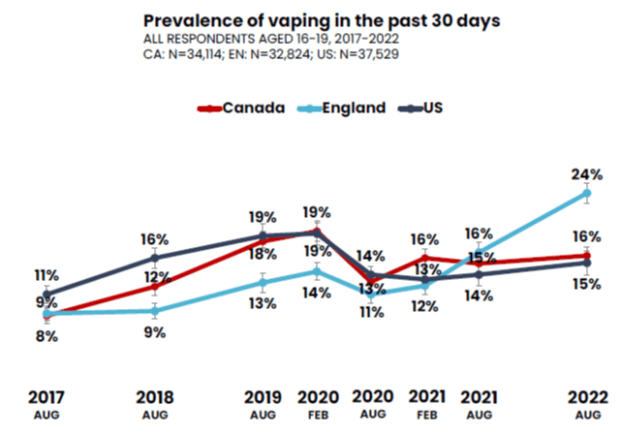In April 2023, David Hammond and colleagues published trends in high school use of e-cigarettes, cigarettes and other tobacco products in three e-cigarette-countries with policies to promote adult use of e-cigarettes for harm reduction: England, Canada and the US. In the International Tobacco Control Policy Evaluation Project (ITC) Youth Tobacco and Vaping Survey England, which most enthusiastically promotes e-cigarettes, has by far the worst results. By 2022, current e-cigarette use was 50% higher than in the US and Canada, with the highest heavy use (20+ days/month) of all three countries.

For comparison, e-cigarette use in Brazil, where e-cigarettes are illegal, was 2.8% for youth age 13-17 in 2019.

In all three countries, the health authorities promote e-cigarettes as a safer alternative to smoking (as do Health Canada and the US FDA) for adults despite real world evidence that e-cigarettes increase harm, again with England pushing this message hardest.
E-cigarette advocates have dismissed the increase in youth use, arguing that they were diverted from combusted cigarettes to e-cigarettes. That didn’t happen in England either: From 2017 to 2022 youth e-cigarette use increased by 16% (from 8% to 24%) while cigarette smoking increased by 5% (from 16% to 21%). In addition, England, which has by far the highest level of smoking among these youth and the highest fraction of heavy (20+ days/month) smoking among youth.
This increase in smoking accompanying the increase in e-cigarette use is precisely what one would predict from the gateway effect – the fact that e-cigarettes attract low risk you to nicotine addiction, with some adding or transitioning to cigarettes. While the US and Canada have not seen an increase in youth smoking, the widespread use of e-cigarettes was followed by a slowing in the decline of smoking.
While the e-cigarette enthusiasts in and out of government in England and Canada are finally beginning to stop minimizing youth use and talking about how to deal with it, the reality is that there is no way to discourage youth use while, at the same time, promoting e-cigarettes for adult smokers.
The US is doing better because the FDA has at least started to address the problem and, more important, local and state governments have been acting to discourage e-cigarette use by prohibiting the sale of flavored e-cigarettes as part of broader efforts to end the sale of all flavored tobacco products. Even the FDA continues to promote the myth that e-cigarettes as consumer products provide “an off ramp for smoking” despite consistent epidemiological evidence that in the real world e-cigarettes do not help smokers quit and in the long run, keep smokers smoking.


The citation for the full report, which has more detailed results, is: Hammond D, Reid Jl, Burkhalter R, Hong D. Trends in Smoking and Vaping Among Young People: Findings from the ITC Youth Surveys. April 2023; University of Waterloo (PDF).

June 29, 2023
Hi Stan,
Thank you for this information which is timely for Thailand.
We, in Thailand have to convince the newly elected policy makers, and the new cabinet (which is being formed) about the ban of e-cig policy should not be changed.
Nithat Sirichotiratana Mahidol University Bangkok, Thailand
LikeLike